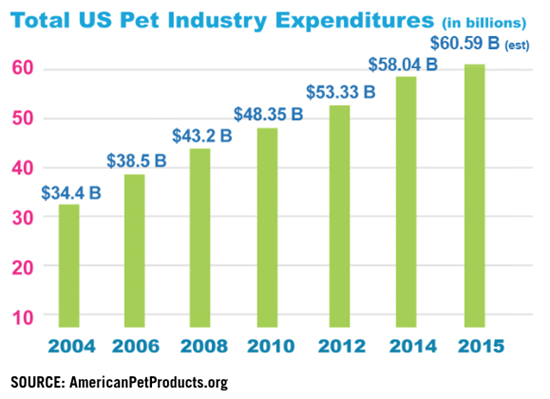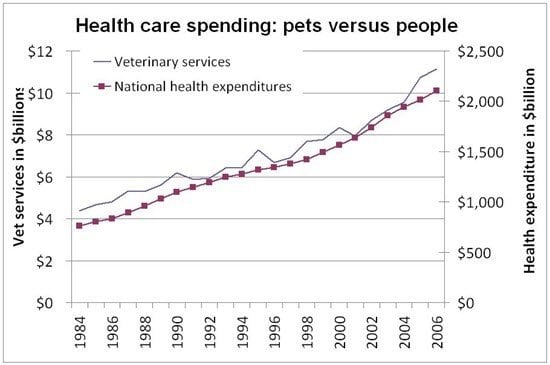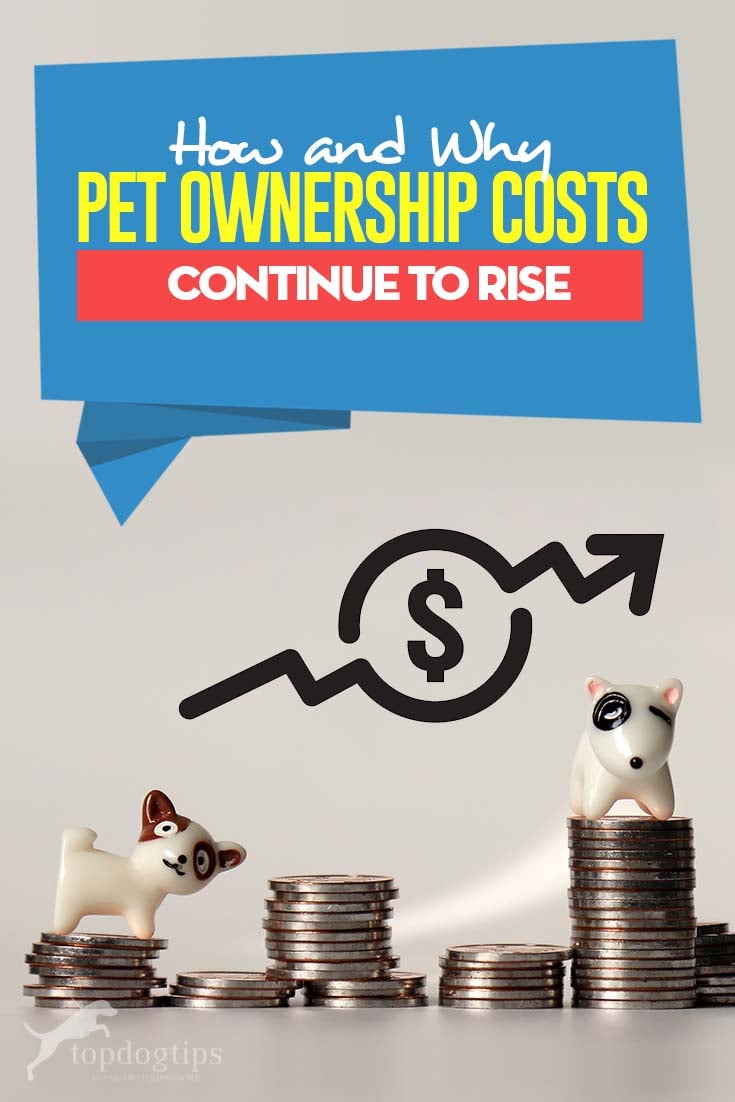If you are a lifelong pet parent, then you have no doubt noticed the continued rise in pet care costs. Lifelong dog care expenses have grown significantly over the last decade, and in particular over the last few years. Here's what's causing those costs to rise and why pet owners are paying more than ever today.
The Data on Rising Costs of Pet Ownership
According to most recent data released by the American Pet Products Association (1), in 2017 pet owners spent close to a whopping $70 billion on their pets. That figure includes toys, beds, foods, and more; it also includes more expensive items like medications and veterinary procedures (2). This clearly shows that the cost of pet ownership is rising and has been rising steadily on an annual basis since 2001.
Pet Industry Expenditures in the United States:
2018 – $72.13 billion
2017 – $69.51 billion
2016 – $66.75 billion
2015 – $60.28 billion
2014 – $58.04 billion
2013 – $55.72 billion
2012 – $53.33 billion
2011 – $50.96 billion
2010 – $48.35 billion
2009 – $45.53 billion
2008 – $43.2 billion
2007 – $41.2 billion
2006 – $38.5 billion
2005 – $36.3 billion
2004 – $34.4 billion
2003 – $32.4 billion
2002 – $29.6 billion
2001 – $28.5 billion

How does this data break down? The American Pet Products Association can only provide data for 2017, and estimated and projected data for years 2018 and 2019 so far, and we can see some of the breakdowns where pet owners spend the most.
2017 – $69.51 billion spending in the U.S. breaks down as follows:
Food – $29.07 billion
Supplies/OTC Medicine – $15.11 billion
Vet Care – $17.07 billion
Live animal purchases – $2.1 billion
Grooming & boarding – $6.16 billion
2018 – $72.13 billion spending in the U.S. breaks down as follows:
Food – $29.88 billion
Supplies/OTC Medicine – $15.51 billion
Vet Care – $18.26 billion
Live animal purchases – $2.01 billion
Other Services – $6.47 billion
As you can see from the data above, the only area where pet spending has decreased is live animal purchases. This fact isn’t too surprising, however, considering the rising awareness of the pet overpopulation problem.
But why are these other pet care costs still rising rapidly after nineteen years?
An Increase in Pet Ownership
According to the American Pet Products Association’s recent data release, some 56% of US homes owned pets in 1988 (the first year that a census of pet-owning households was held.) According to the 2017-2018 data release from APPA, that number has now skyrocketed to 68%. Of that 68% of American households, 60.2 million U.S. households own dogs and in total, 89.7 million dogs are owned by those households.
The average cost of basic annual pet related expenses for just one of those single dog-owning households? APPA 2017-2018 data breaks it down as follows:
- Surgical Vet Visits – $474/year
- Routine Vet – $257/year
- Food – $235/year
- Food Treats – $72/year
- Kennel Boarding – $322/year
- Vitamins – $58/year
- Groomer/Grooming Aids – $84/year
- Toys – $47/year
That’s a grand total of $1,549 per year. Although if you’re like us, when you look at some of those numbers you will laugh. For example, $235 a year on dog food, that obviously won’t quite cover it for most dog owners. That comes out to around $19.58 per bag of food per month and for most of us, that’s just not going to happen and if you have a dog with special dietary needs, well, that figure goes out of the window after three bags of food.
As more families are bringing home their newly adopted pets, of course, we are going to see the annual spending on pet related products rise, that’s just common sense. But why are more families bringing home pets?
We can’t point to just one cause, but a few influencing factors include:
Parental roles. Couples are having children later in life but still have a desire to bond over parental roles so they are bringing home pets with increased frequency and treating them as “starter children” (3).
Pets over kids. Statistically, fewer and fewer couples in the United States are choosing to have children at all, and these couples often meet their innate parental desire by adopting a pet instead (4).
Health benefits. Increased research into the physical and mental health benefits of having pets has at least in part contributed to the rising number of households adding pets to their family (5).
Pet Healthcare Costs
Is it the increase in pet ownership that is leading to increased veterinary costs? According to the APPA current data release, from 2017 to 2018, spending on veterinary care has increased by $1.19 billion. There are many who believe that it is less “supply and demand” and increasing veterinary costs that are increasing veterinary spending and more pet parents simply being more willing to spend on veterinary care.

According to recent articles, pet parents today are much more open to seeing their dog as a part of their family and as such, they provide for their veterinary care as they would for medical care for any other member of the family. This is just a part of what people refer to as a shift from the “Snoopy generation.”
While thirty years ago families saw their dogs as pets that lived outside and were much more isolated from the family, today our dogs have become much more of an extension of the family unit. This is further evidenced by the fact that pet parents are spending more on over-the-counter pet treatments as well. According to the current APPA data from 2017 to 2018, spending on pet supplies including over the counter medications has increased by $400 million.
But aren’t veterinary care costs rising? Yes, there is no doubt that veterinary costs for treatments are rising, but the increase is certainly not as dramatic as some would have you think and it often only reflected in less common veterinary treatments and treatments used to prolong our pet’s lives.
For example, the monthly cost of a single heartworm pill for dogs has remained relatively stable over the past decade; however, advances in veterinary technology have led to the development of treatments that were unheard of ten years ago. Of course, the research and development of these treatments come at a cost, but it’s one that most pet parents are willing to pay.
Pet Insurance and Its Cost
There is also the added consideration of pet insurance when we talk about the rising cost of caring for our pets. This is something of an offshoot of pet healthcare costs simply because as we have shifted from that “Snoopy generation” to a generation of pet parents, we are doing everything we can to provide more advanced veterinary care for our pets and that often means investing in pet insurance.
According to the Insurance Information Institute (7), the number of pets that were insured in North America and Canada rose by an incredible 17% between 2016 and 2017. Wondering what kind of a boom that was for the pet health insurance sector in North America for 2017? Well, according to III, the gross written premiums for pet insurance hit $2.1 billion at the end of the year. That’s a 23% increase in gross premiums from 2016.
Increasing Food Choices and Dietary Trends
One of the biggest jumps in pet ownership cost over the past few years can be attributed to the pet food industry. According to the APPA, recently released data from 2017 to 2018, spending on pet food has increased by $810 million. Why the incredible increase? There are multiple factors to blame:
Better food. As we look back to the shift from the “Snoopy generation” we have shifted towards feeding our dogs healthier and more nutritionally sound foods. Where once dogs were fed just table scraps, now they are being fed specialty diets.
Brand scrutiny. Amid the plethora of pet food recalls over the past few years, more and more pet parents are choosing to feed pet foods that come from smaller companies with more stringent quality control procedures. These companies are not afforded the mass discounts of major manufacturers and this drives up the cost of their foods.
Health awareness. More pet parents are becoming more involved in their pet’s health. They are educating themselves about the content of their pet’s food (a side effect of the many recalls that have taken place) and are making more educated choices about the food that they feed their pets.
Marketing. More pet food companies are taking advantage of pet parents by preying on their vulnerabilities after mass recalls. By advertising specific ingredients and non-ingredients in their foods, they are able to market foods at a more expensive price and pet parents are willing to buy it if they believe that the food is a better choice for their pet.
Fad diets. More pet food companies are promoting “fad diets” for pets, knowing that pet parents will do what they must to care for their four-legged children in today’s society. For example, almost every dog food company these days promotes “grain-free” food, even though not every dog will thrive on a grain-free diet and some dogs will even suffer (8).
Increased Lifespan of Pets
There are many factors that influence your dog’s lifespan, and these include diet, genetics, breed, size, veterinary care, and more. With that in mind, there are multiple studies that have shown that over the past decade, the average lifespan of our dogs is increasing.
For example, one Japanese study on the average lifespan of companion dogs in Japan found that over the past three decades, the average lifespan of these dogs has dramatically increased 1.67 times from 8.6 years to 13.7 years (9). Other breed-specific studies have found similar results among particular breed groups both large and small.
What does this data mean for the cost of pet care? With our dogs living longer, we are, of course, spending more on caring for them. If you ask us, though, this isn’t a bad trade-off and we are certainly willing to pay for those additional years.
Will the Rise of Pet Costs Ever Going to Stop?
Are these rising costs of pet ownership ever going to stop? Very unlikely. However, while they will continue to rise, there's data to suggest we are likely to see them begin to slow down. As we shift into a more pet-centric society, it has become the norm to provide our pets with “better” and while we hope that everyone will continue to shift to this way of thinking, we believe that we’ve already seen the most significant change take place.
READ NEXT: How Much Does a Dog Cost?













